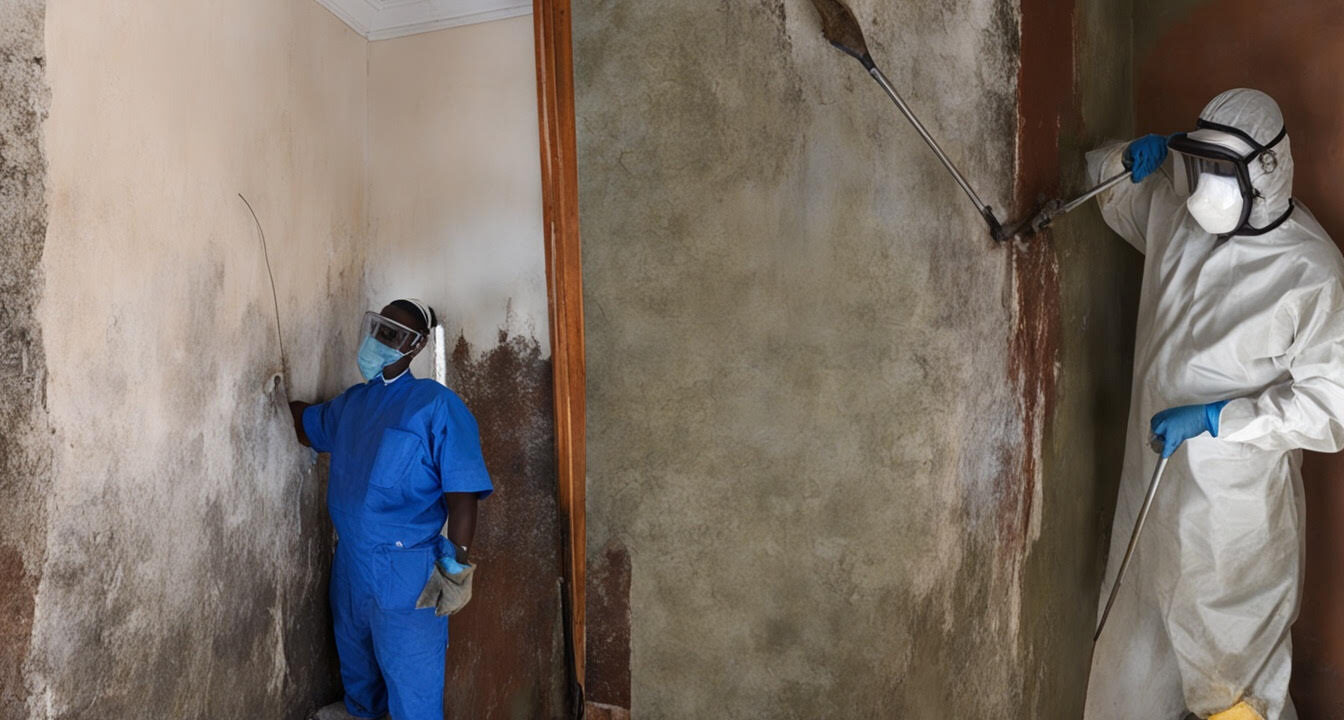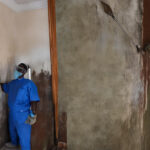
In Kenya, mold in homes and workplaces can be a big health risk. If not controlled, mold can cause breathing problems and other health issues. Luckily, there are professional mold removal services in Kenya to help. This guide will cover how to clean up mold, why it grows, and the health risks of mold.
By learning about mold removal steps, Kenyan homeowners and business owners can protect their spaces. This article will show you how to find the mold source and remove it right. It aims to give you the knowledge to tackle mold removal in Kenya.
Key Takeaways
- Mold removal services in Kenya are key for dealing with mold and keeping air clean.
- Knowing why mold grows and its health risks is important for effective removal.
- The mold cleanup process includes steps like finding, containing, and removing mold fully.
- Choosing a skilled mold removal company is key for a safe and successful cleanup.
- Stopping mold from coming back means fixing the cause and taking steps to prevent it.
Understanding Mold: Causes and Health Risks
Mold is a common problem in homes and buildings in Kenya. It’s important to know why mold grows and the health risks it poses. This knowledge helps keep our living spaces safe and healthy.
What Causes Mold Growth?
Mold loves damp, humid places. It often shows up where there’s poor air flow or water damage history. The main causes of mold are:
- Leaks in roofs, walls, or plumbing systems
- High humidity levels
- Flooding or water getting in
- Not enough air flow in places like bathrooms and kitchens
These mold growth triggers create the perfect setting for mold spores. This leads to the growth of harmful mold colonies.
Potential Health Hazards of Mold Exposure
Being around mold can be harmful, especially for people with breathing problems or weak immune systems. The health effects of mold include:
- Respiratory issues, such as asthma, bronchitis, and pneumonia
- Allergic reactions, including sneezing, coughing, and skin irritation
- Neurological symptoms, such as headaches, dizziness, and memory problems
- Weakened immune system and more infections
Long-term mold exposure can cause serious health issues. This shows why it’s crucial to deal with mold quickly and well.
Identifying Mold Problems in Your Home
It’s key to spot mold growth in your home early. Mold hides in many places, so keep an eye out. Knowing the signs of mold helps you tackle the issue fast.
Visible mold is a clear sign. Look for colors like green, black, or white on walls, ceilings, or surfaces. Don’t forget to check behind wallpaper, under carpets, or inside ducts.
A musty smell often means mold is around, even if you can’t see it. This smell is a warning sign you shouldn’t ignore.
Water damage often leads to mold. Watch for leaks, floods, or too much moisture. Places with high humidity or poor air flow are more likely to have mold.
If you think there’s mold, act fast. Mold testing and mold inspection can show how bad it is and what to do next. If you’re unsure, get professional help right away.
“Addressing mold issues promptly is essential for protecting the health and safety of your family.”
Mold Removal Services in Kenya | How It’s Done
Dealing with mold at home? Go for professional mold removal services in Kenya. These experts use a detailed professional mold removal process. They work to safely remove mold and make your home healthy again.
Step-by-Step Mold Removal Process
Here’s what professional mold removal companies in Kenya do:
- They check the mold growth to see how bad it is.
- They seal off the mold area to stop spores from spreading during cleanup.
- They clean and remove all mold with special tools and methods.
- They disinfect surfaces to kill any mold and spores left behind.
- They fix the moisture problem that caused the mold in the first place.
- They check again to make sure all mold is gone and everything is fixed.
Professional Equipment and Techniques
Experts in Kenya use specialized equipment for mold removal for a safe and effective job. This includes:
- High-Efficiency Particulate Air (HEPA) air scrubbers to catch mold spores during removal.
- Commercial-grade dehumidifiers to keep moisture levels low and stop mold from coming back.
- Antimicrobial treatments to clean and sanitize surfaces.
- Protective gear like respirators, gloves, and coveralls to keep workers safe.
With these professional mold remediation techniques, experts in Kenya can fully tackle tough mold problems. They make your home safe and improve the air quality inside.
Choosing a Reputable Mold Removal Company
When dealing with mold at home, picking a trustworthy mold removal contractor is key. The skills and experience of the company you pick can greatly affect the mold removal’s success. Also, checking out customer feedback can give you insights into the service quality and how happy customers are.
Credentials and Experience
It’s crucial to check a mold removal company’s credentials and experience before hiring. Make sure they have certified mold remediation experts. These experts have the right training and certifications. This means they know how to safely and effectively remove mold.
Also, think about how long the company has been in business. A company with a long history is more likely to offer top-notch services and good results for your home.
Customer Reviews and Testimonials
Looking into customer reviews and testimonials can give you a lot of useful info. Search for feedback from past clients that talks about the company’s quickness, professionalism, and how well they remove mold.
- Focus on comments about how on time the company was, how they communicated, and if they followed safety rules.
- Look for feedback on the final results of the mold removal and if clients were happy with the whole process.
- Check out online ratings and reviews from trusted sources to get a full picture of the company’s reputation.
Choosing a mold removal company with the right credentials, experience, and good customer feedback means you can trust your mold remediation project. You’ll also be protecting your home’s health for the long term.
Preventing Future Mold Growth
Keeping your living or working space mold-free is key for health and safety. To avoid mold problems later, focus on controlling moisture, improving ventilation, and using mold-resistant building materials.
First, tackle the main issue – moisture. Find and fix water leaks, high humidity, and condensation to stop mold before it grows. This means fixing leaks, ensuring good drainage, and using dehumidifiers to keep humidity in check.
Next, work on ventilation. Good air flow removes excess moisture and stops warm, humid air from causing mold. Think about upgrading HVAC systems, adding exhaust fans in bathrooms and kitchens, and making sure air moves well everywhere.
For mold-resistant home construction, there are key steps. Use materials like cement-based siding and drywall that fights mold. Also, ensure your building is well-insulated and sealed to keep moisture out and mold away.
“An ounce of prevention is worth a pound of cure when it comes to mold. Taking proactive steps to control moisture and improve ventilation can go a long way in keeping your home or business mold-free for years to come.”
By using these mold prevention strategies, you can greatly lower the chance of mold problems later. This ensures a healthy, safe, and mold-free place for everyone.
Mold Remediation Costs in Kenya
Mold remediation can be a big expense. The costs change based on several things. Knowing what affects the price helps homeowners in Kenya plan their budget for mold cleanup.
Factors Affecting the Cost
The price of removing mold in Kenya depends on many things, including:
- The extent of the mold infestation: More mold means more work and a higher cost.
- The size of the affected area: Bigger areas need more materials and labor, raising the price.
- The complexity of the project: Tough-to-reach mold or mold in structural parts makes the job harder and more expensive.
- The need for specialized equipment or techniques: Advanced tools and methods for hard mold cases add to the cost.
- The location of the property: Costs can change based on where the property is in Kenya.
On average, mold removal in Kenya costs between KES 50,000 and KES 200,000. This depends on the mold’s spread and the project’s complexity. Homeowners should get quotes from several mold removal companies to find the best deal for their budget.
| Factors | Average Cost Range (KES) |
|---|---|
| Small Mold Infestation (less than 10 sq. m) | 50,000 – 100,000 |
| Medium Mold Infestation (10-50 sq. m) | 100,000 – 150,000 |
| Large Mold Infestation (over 50 sq. m) | 150,000 – 200,000 |
By thinking about these factors and budgeting well, homeowners in Kenya can be ready for mold remediation costs. They can make smart choices for their homes.
DIY vs Professional Mold Removal
When dealing with mold at home, you can choose between doing it yourself or hiring experts. For small mold issues, you might handle it on your own. But for big or severe cases, you should get help from mold removal pros.
When to Consider Professional Help
Here are some situations where you should call in the pros:
- Extensive Mold Growth: If mold covers a big part of your home, get professional help. Dealing with a big mold job by yourself is hard and might not fix the main issue.
- Hidden Mold: Mold can hide in spots like behind walls, under floors, or in air systems. Experts have the right tools and knowledge to find and fix these hidden mold problems.
- Health Concerns: Some mold types can be harmful, especially for people with breathing problems or weak immune systems. A professional mold removal team ensures the mold is safely removed.
- Structural Damage: If mold has damaged your home’s structure, like causing wood to rot or weaken, you need professional help to fix it.
For small, isolated mold issues, you might try DIY removal. But knowing when to ask for professional help is key for safe and effective mold removal.
Common Mistakes to Avoid During Mold Removal
Mold removal is a key task that needs careful attention. Many homeowners and some pros make mistakes that can cause more problems or health risks. Knowing these mistakes helps ensure a safe and effective mold removal process.
One big mistake is improper containment. Not isolating the mold can spread it to other home areas, making things worse. Not cleaning well can also leave mold behind, causing it to come back.
Using the wrong methods to remove mold is another error. Some try to use bleach or harsh chemicals, which can be dangerous. Not fixing the mold’s cause can lead to it coming back later.
To avoid these errors, it’s key to follow a detailed mold removal process. This often means hiring a professional mold removal company. They have the right training, tools, and experience to safely and effectively handle mold problems.
Mold Removal Mistakes to Avoid
- Failing to properly contain the affected area
- Using inadequate cleaning methods or materials
- Neglecting to address the underlying cause of mold growth
- Attempting DIY mold removal without the proper knowledge and equipment
- Overlooking potential health hazards associated with mold exposure
| Common Mold Removal Mistakes | Potential Consequences |
|---|---|
| Improper containment | Spread of mold spores to other areas |
| Inadequate cleaning methods | Residual mold contamination and regrowth |
| Failing to address root cause | Recurring mold issues |
| Attempting DIY mold removal | Exposure to health hazards and ineffective remediation |
“Effective mold removal requires a comprehensive and professional approach to ensure the safety of both the occupants and the property.”
Knowing these mold removal mistakes helps homeowners make better choices. They can then get help from qualified pros for a safe and successful mold removal.
Restoring Indoor Air Quality After Mold Removal
Removing mold is just the start to a healthy home. After getting rid of the mold, it’s key to work on the air quality. This means using air purifiers, making sure there’s good airflow, and checking the air quality often.
It’s vital to make the air clean and safe after removing mold. Air purifiers can take out mold spores and other harmful stuff in the air. Opening windows or using fans can also help clean the air.
Checking the air quality often is important to make sure the mold removal worked well. This can be done with professional checks or by using devices at home to monitor the air.
“Taking proactive steps to restore and maintain excellent indoor air quality is a critical part of the mold removal process. It’s not enough to simply eliminate the visible mold; we must ensure the air is clean and safe for occupants.”
By focusing on making the air clean after removing mold, using air purifiers, and checking the air quality, homeowners can be sure their homes are safe. They can also reduce the chance of mold coming back.
Conclusion
This guide has covered the key points of mold removal services in Kenya. It gives you the knowledge to tackle mold problems well. We looked at why mold grows, its health risks, how to remove it, and why picking a good service is crucial.
For dealing with mold in Kenya, it’s important to spot early signs and prevent growth. Sometimes, you’ll need to call in experts. This guide has shown you how to do this right.
Homeowners, property managers, and business owners can use this guide to keep their spaces safe. It’s a great tool for fighting mold and keeping everyone healthy. By being informed and acting fast, you can make your place mold-free and safe.
FAQ
What causes mold growth in homes or buildings?
Mold grows when there’s too much moisture, poor air flow, or water damage. Leaks, high humidity, and not enough air can make a place perfect for mold.
What are the potential health risks of mold exposure?
Being around mold can cause health problems like breathing issues, allergies, and serious conditions. It can make asthma worse, cause infections, and harm existing lung problems.
How can I identify mold in my home or workplace?
Look for mold, musty smells, and water damage to spot mold. A detailed check of your place can find mold early.
What is the process for professional mold removal?
Removing mold professionally means several steps. First, contain the area. Then, remove moldy materials. Clean well, and use special tools and methods for total mold removal.
What should I look for when choosing a mold removal company?
Pick a mold removal company by checking their skills, experience, and reviews. Make sure they’re licensed, insured, and use the right gear and methods.
How can I prevent future mold growth in my home or building?
Stop mold by fixing moisture issues, improving air flow, using mold-resistant materials, and checking for mold often.
How much does professional mold removal cost in Kenya?
Mold removal costs in Kenya change based on how bad the mold is, the size of the area, and the project’s complexity. Get quotes from several trusted companies to find the best deal for your needs.
When should I consider hiring a professional for mold removal, rather than attempting a DIY approach?
For big or severe mold problems, or if mold is in tough spots, hire a pro. They have the right skills, tools, and safety steps to do the job right and safely.
What are some common mistakes to avoid during mold removal?
Avoid wrong containment, bad cleaning, not fixing mold’s cause, and not being safe during removal.
How can I improve indoor air quality after mold removal?
Better air quality after removing mold means using air purifiers, improving air flow, and keeping an eye on air quality to keep the space healthy and safe.
Attachments area
Preview YouTube video Black Mold – How To Kill Toxic Mold In Under 5 Mins!

Black Mold – How To Kill Toxic Mold In Under 5 Mins!










